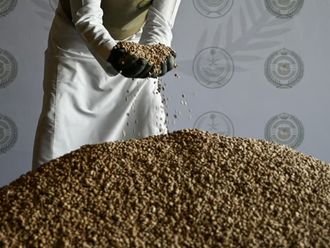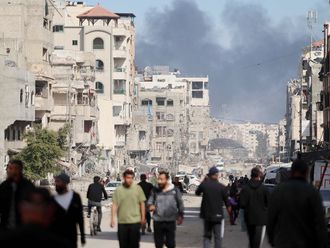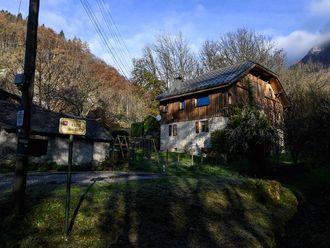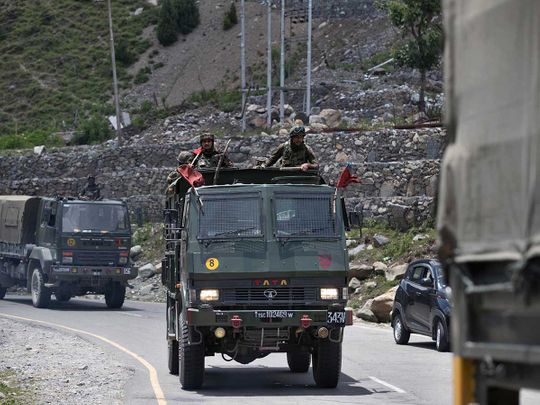
Delhi: India and China agreed Wednesday to ease tensions at their disputed Himalayan border, even as they traded blame for a brawl that left at least 20 Indian soldiers dead.
The two nations' foreign ministers spoke by telephone to calm nerves after a high-altitude melee involving fists, rocks and clubs, AFP reported.
The call between China's Wang Yi and India's Subrahmanyam Jaishankar came as sources told AFP that Indian paramilitaries were being deployed to the area of the skirmish high in the Himalayas opposite Tibet.
China's state broadcaster CCTV, meanwhile, showed footage of People's Liberation Army tanks and soldiers holding live fire drills in Tibet.
China has refused to confirm if it suffered any casualties in the first deadly clashes at the border in decades, although Indian media said at least 40 Chinese troops were killed or seriously hurt.
The Chinese foreign ministry said in a statement that Wang demanded "India conduct a thorough investigation" and punish those responsible.
"The Indian side must not misjudge the current situation, and must not underestimate China's firm will to safeguard its territorial sovereignty," it added.
India's foreign ministry said Jaishankar "conveyed the protest" of his government.
He warned that "this unprecedented development will have a serious impact on the bilateral relationship" and urged Beijing to "take corrective steps".
But the two ministers also sought to de-escalate tensions.
China said both sides agreed to "cool down the situation on the ground as soon as possible".
India's foreign ministry said the two sides would implement a previously agreed disengagement, and "neither side would take any action to escalate matters".
What is the ‘Line of Actual Control’ and why does it matter?
Six decades ago, India and China went to war over a border dispute that ended with an uneasy truce in 1962. While no border has ever officially been negotiated along the forbidding stretch of land high in the Himalayas that divides the two nations, the truce established a 3,360km long Line of Actual Control. Since then, an uneasy peace has held. But every time there is a flare-up of violence, the world watches anxiously. China and India are the two most populous nations on earth, both armed with nuclear weapons, led by governments that have built support, in large part, by appeals to nationalist sentiment.
What are China and India fighting over?
While the Line of Actual Control (LAC) was devised to create a demarcation line and to ease tensions between the nations after the 1962 war, many areas remain in dispute.
Both China and India have pressed their claims by building up infrastructure such as roads, telephone lines and airstrips, and by sending troops on regular patrols.
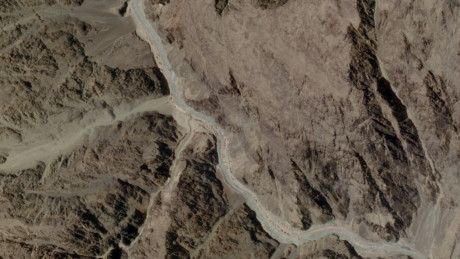
The demarcation line runs through a territory known as Ladakh. It is part of Kashmir but located in the region’s lesser-known Buddhist region, bordering Tibet. Sitting at the crossroads of several important trade routes, the territory has a rich history of commerce. But that came to an end when China closed the borders with Tibet and Central Asia in the 1960s. Now, the sparsely populated but stunningly beautiful land is mostly known as a tourist destination.
What led to the current standoff?
Military experts say one reason for the current face-off is that India has been building roads and airfields to improve connectivity and narrow the gap with China’s superior infrastructure on its side of the LAC.
We of course don’t wish to see more clashes. We once again ask the Indian side to act on our consensus, strictly discipline its front-line troops … and not to take unilateral actions that might complicate the situation.
In May, a brawl broke out between Chinese and Indian soldiers stationed at camps high in the Himalayas. Beijing’s reaction was swift and forceful. Chinese troops confronted Indian soldiers at several other remote border points in the mountains, some more than 1,600km apart. Since then, both armies have rushed in thousands of reinforcements. Indian analysts say that China has beefed up its forces with dump trucks, excavators, troop carriers, artillery and armoured vehicles and that China is now occupying Indian territory — a charge denied by Beijing.
What has been China’s reactions to the escalation?
Beijing has agreed to de-escalation of the situation and ruled out any violence. But foreign ministry spokesman Zhao repeated Chinese claims that the clashes came after Indian forces “provoked and attacked Chinese personnel, which led to fears, physical confrontation between the two sides’ border troops and resulted in casualties.” China has not said if any of its troops were injured or killed. “China has lodged strong protests and stern representations with the Indian side. We once again ask the Indian side to act on our consensus, strictly discipline its front-line troops not to cross the line, not make provocations and not to take unilateral actions that might complicate the situation,” Zhao said.
How has India reacted?
The deaths of the Indian soldiers “will not be in vain”, Indian Prime Minister Narendra Modi said Wednesday. “I would like to assure the country that the sacrifice of our soldiers will not be in vain. For us, the unity and integrity of the country is the most important … India wants peace but is capable of giving a reply if provoked,” Modi said in a televised address. Earlier, India’s main opposition Congress party leader Rahul Gandhi urged Modi to reveal the ground reality of the incidents. “Why is the PM silent? Why is he hiding? Enough is enough. We need to know what has happened,” the Congress leader tweeted. Modi has called for an all-party meeting to discuss the situation on June 19.
I would like to assure the country that the sacrifice of our soldiers will not be in vain. For us, the unity and integrity of the country is the most important … India wants peace but is capable of giving a reply if provoked.
Why did the troops fight with rods, sticks and stones?
A past agreement between India and China stipulates that border patrols from either side should not carry firearms or open fire near the LAC. But violent, high-altitude disputes have erupted several times without guns being involved. Monday’s deaths were the first since a major border clash in 1967 between the world’s two most populous countries. Hundreds were killed in those battles. India and China fought a brief but bloody border war in 1962 and distrust has occasionally led to flare-ups ever since. Infrastructure building near or within disputed territories is often blamed for increases in tensions. The LAC is largely based on the ceasefire line after the war in 1962, but both sides disagree on where it lies.
So what happens next?
Military and political analysts say the two countries do not want a further escalation — particularly India, where military forces are nowhere near as powerful as China’s. “Neither PM Modi nor President Xi want a war, but neither can relinquish their territorial claims either,” said Ashley J. Tellis, a senior fellow at the Carnegie Endowment for International Peace in Washington. “Over the past several decades there’s been incessant confrontation between China and India, but proudly there have been no shots fired or deaths,” said Long Xingchun, a professor at China West Normal University in southwest China who studies relations with India. The US State Department said it was “closely monitoring” the dispute. “Both India and China have expressed a desire to de-escalate, and we support a peaceful resolution of the current situation,” it said in a statement.
— With inputs from NYT, Reuters, AFP, Bloomberg & BBC
A RIVER RUNS THROUGH IT
Why is Galwan river valley so important for India and China?
• The Galwan river valley is a rocky, icy, inhospitable slice of the Himalayas at an altitude of 14,000 feet, off-limits to all but a few lonely herdsmen and Indian and Chinese troops, and considered a point of great strategic importance for both India and China. The river is believed to be named after Ghulam Rasool Galwan, an explorer from Leh, who, while leading a British expedition in the Chang Chenmo valley, first discovered the path leading to the river. The site lies amid remote jagged mountains abutting the Aksai Chin plateau that is claimed by India but is administered by China.
• Recent Indian construction activities, including that of a bridge across Shyok river, and the 255km Darbuk-Shyok-DBO road that is expected to provide a crucial connection between Leh and Daulat Beg Oldie, close to the Line of Actual Control (LAC), have drawn Chinese anger back. But India says all the construction is on its side of the LAC.
• Both China and India run patrols along the border. The soldiers are under strict orders not to carry firearms or shoot, but that doesn’t stop them from throwing rocks or fighting with crude weapons.
What happened at the Galwan river valley on Monday night?
• Both India and China have blamed each other for the violence along the LAC, the boundary that emerged from the 1962 war, on Monday night.
• “The Indian military broke their promises and once again crossed the Line of Actual Control to engage in illegal activities,” said Colonel Zhang Shuili, a Chinese military spokesman. “They deliberately launched a provocative assault, leading to an intense physical clash that caused death and injury.” Chinese foreign ministry spokesman Zhao Lijian separately told reporters that China has lodged “strong protests and stern representations” with the Indian side. “We once again ask the Indian side to act on our consensus, strictly discipline its front-line troops not to cross the line, not make provocations and not to take unilateral actions that might complicate the situation,” he said.
• An Indian military official said the clash started during a meeting attended by hundreds of soldiers on both sides who had come together along the border to discuss efforts to de-escalate tensions. But Chinese officers insulted them at the meeting on Monday night, which triggered a fight between soldiers that quickly spiralled into major violence. “A violent face-off happened as a result of an attempt by the Chinese side to unilaterally change the status quo,” said a statement from Indian government spokesman Anurag Srivastava. “Both sides suffered casualties that could have been avoided had the agreement at the higher level been scrupulously followed by the Chinese side.”
• According to Indian and US media reports, the fighting at Galwan began after Indian troops under Colonel Santhosh Babu’s command dismantled a Chinese tent set up near a position code-named Patrol Point 14, close to the mouth of the Galwan river. The tent had been dismantled following a meeting between Lieutenant General Harinder Singh, who commands the Leh-based XIV Corps, and Major-General Lin Liu, the head of the Xinjiang military district, but was allegedly set up again by the People’s Liberation Army (PLA). It was after dismantling the tent that furious hand-to-hand fighting broke out across the Galwan river valley for more than eight hours on Monday night.
• China’s People’s Liberation Army (PLA) teams armed with iron rods, bamboo sticks studded with nails and batons wrapped in barbed wire clashed with troops of India’s 16 Bihar Regiment led by Col Babu, according to Indian military officials. Chinese officials have not released any details about the clashes or casualties.
• Unarmed Indian soldiers who fled into the remote hillsides were hunted down with thermal imaging drones, while some soldiers jumped into the icy Galwan river in efforts to escape and died of hypothermia, Indian military officials said. At least another two dozen Indian soldiers are battling life-threatening injuries, and more than 110 have needed treatment, an Indian military officer with knowledge of the issue said.




